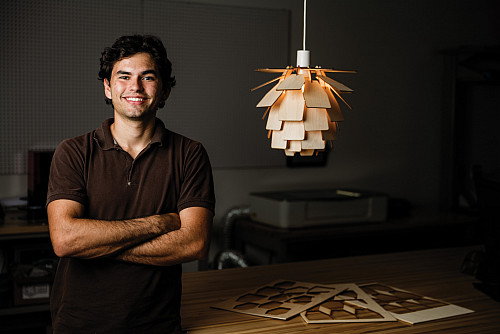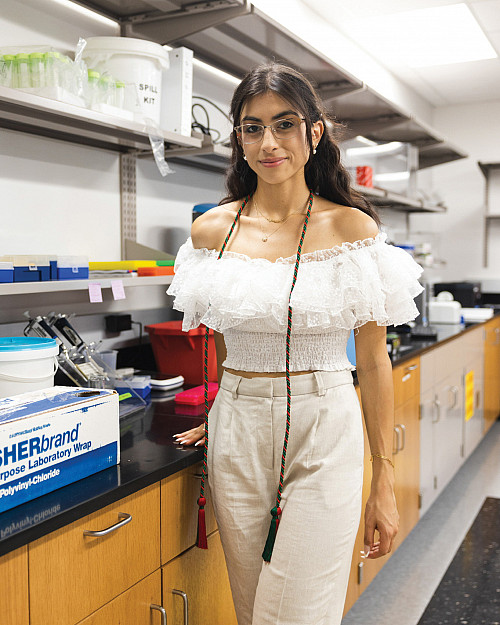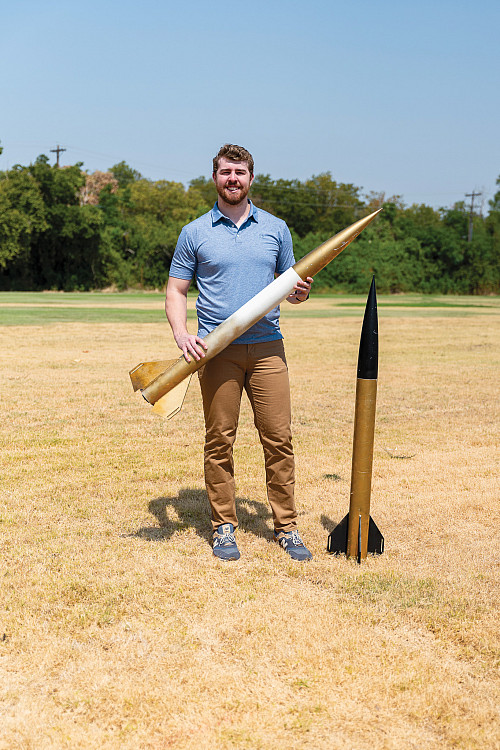News
Inquiring Minds Innovative Research
Student researchers explore interests, prep for the future
December 18, 2023
December 18, 2023
Open gallery

When most people think of research, they picture someone in a white lab coat peering through a microscope or mixing test tubes. They don’t usually envision someone building a mid-century modern light fixture from scratch or launching a rocket in a large open field. At Southwestern, students engage in a variety of creative and research projects that further their knowledge across a range of disciplines and facilitate a deeper understanding of the world around them.
Students also have the opportunity each spring to present their original work at the King Creativity Symposium and the Research and Creative Works Symposium. Recent projects have highlighted the diverse interests and skills of Southwestern’s talented scholars.
Designing for Function and Form

This project was a study of the famous artichoke lamp designed by Danish architect Poul Henningsen in 1958. As the name implies, the lamp features a series of layered leaves, or shades, that conceal the light source, resulting in a warm and glare-free glow. After studying the geometry of the lamp and sketching out his own design, Johnson built it using 3D modeling and design software and a laser cutter.
“I put a lot of my own creative input in it, which was really fun,” Johnson explains. “I was able to create forms from my own ideas and put them together to see if I liked it. Then I would try again and print several times, over and over. Finally, once I had the form I wanted for each piece, I did my final print, and then I sanded everything and assembled it.”
Parts of the project were more challenging than expected. Johnson says he still hasn’t fully mastered Rhino 7, the computer-aided design program he used to create his design, and the materials he initially ordered weren’t what he expected. He believes the final result was well worth the effort, however.
“I now have an accredited, valuable experience that demonstrates my ability to motivate myself and achieve a result,” he says. “I have a lot more confidence in myself, and I can use the project in my portfolio, which will strengthen my grad school application.”
Joseph “Joey” King ’93, who endowed the King Creativity Fund in 2000, noted the considerable effort Johnson put into his work and the refinement of the final product. King ultimately selected Johnson’s project for the Walter Milton Potter Prize, which is awarded each year to the best student or project.
Crosby, Johnson’s sponsor for the project, agrees with King’s observations. “I was really impressed by Oliver’s commitment to design and how thorough he was throughout the whole process,” he says. “He was very iterative and always made progress toward his goal.”
Empowering Nicotine Users to Quit

Nicotine addiction remains an ongoing issue on college campuses across the nation, especially as electronic cigarettes continue to rise in popularity. When Cynthia Bashara ’23 arrived on the Southwestern campus as a first-year student, she was surprised at how many of her peers vaped—and how many wanted to quit the unhealthy habit but couldn’t.
“I saw my friends trying to quit, but they never actually did. It would just be a lot of back and forth,” says Bashara, who is majoring in biology. “I started looking at what the CDC recommended for quitting, which is a combination of patches and gum that costs almost $60 a week. There’s no incentive for anybody to quit when it’s that expensive.”
Bashara decided to create that incentive herself. She applied for a grant from the King Creativity Fund to build a free app designed to offer a personalized approach to quitting. After receiving the award, she reached out to Professor of Psychology Fay Guarraci, who has conducted research on nicotine addiction in rats. Guarraci agreed to sponsor the project, titled “An Algorithm Approach to Nicotine Addiction,” and met with Bashara to discuss theories that could underlie her approach. Bashara also recruited Alejandro Medina ’24 to code the app and Annie Bass ’23 to create the artwork.
“It was great how they combined their areas of expertise—very Paideia,” says Guarraci. “They used one field, computer science, to help with a problem in another field, psychology/addiction.”
The app, called QuitNic, uses an algorithm to create a plan tailored to each individual. The algorithm considers a variety of factors, including the user’s current nicotine intake, triggers, and lifestyle to produce a custom plan designed to wean the user off nicotine over a period of time.
“If they smoke first thing in the morning when they wake up, the plan will have them wait ten minutes after waking up on the first day. Then they’ll wait twenty minutes, and after that, they’ll wait an hour,” Bashara explains. “The idea is to slowly change your habits in your brain and eventually replace those habits with something else.”
The app isn’t available yet, but the team hopes it will be soon. “It takes a lot more to make an app than we thought,” Bashara says. “We did finish the algorithm, and that was the main thing. It feels good knowing that once we do get this in the app store, everyone can have at least a chance to quit. There’s no other app that has anything like this.”
Building High-Powered Rockets

The goal of the project was to assemble, test, and launch multiple high-powered rockets. Pyles recruited three fellow physics majors—Braden Anderson ’24, Angel Rodriguez ’24, and Nina Woodward ’24—to assist with the project. The team divided into pairs and built a total of four rockets from a kit in less than two months.
“Noah had to take on a leadership role because he had three other students working with him,” said Crosby, who served as the project’s sponsor. “When leading a research group, you have to be able to bring together people who have different strengths and weaknesses and motivate them toward a singular goal. He grew a lot in that regard.”
Initially, the team members wanted to launch two smaller rockets first as a test, but due to unfavorable weather and scheduling conflicts, they were unable to do so. That means they weren’t entirely sure what to expect when the official launch finally occurred just days before they were scheduled to present their findings at the King Creativity Symposium.
“I can pitch in a really important game and not be as nervous as I was about this launch. It was nerve-wracking,” says Anderson, who plays on the Southwestern Pirates baseball team with Pyles. “But the minute I saw it go straight up, it was all good.”
That rocket, which Anderson and Pyles built together, didn’t just go straight up 2,000 feet into the air; it practically came straight down, landing only about twenty feet from the launch site (“That’s basically unheard of,” Pyles says). The other rocket built by Rodriguez and Woodward also had a successful launch. Pyles and Anderson both earned level 1 high-powered rocketry certification from the National Association of Rocketry.
“There was a lot of preparation. We had to build the rockets and run the simulations. We scheduled and rescheduled the launch multiple times, and then we had to drive an hour and a half out to the launch site. It was kind of surreal to actually slide the rocket onto the stand,” Pyles says. “But it was an awesome experience. It is very rewarding to see something you made out of nothing be a success.”
So the next time you think about research, forget the white lab coat, and let your imagination soar like a high-powered rocket.
Make a gift to Southwestern to help support high-impact experiences like undergraduate research.















